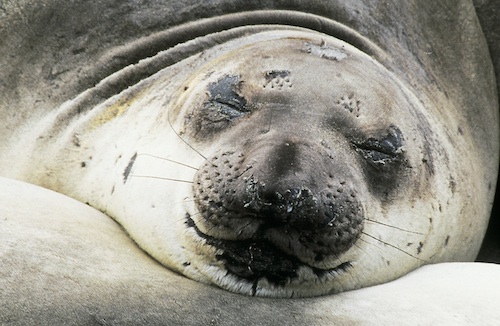Plastic debris' triple whammy of toxins

While plastic refuse on land is a familiar eyesore as litter and a burden on landfills, in the marine environment it can be lethal to sea creatures by way of ingestion or entanglement. Now a new study highlights how ocean plastic debris is also a threat to humans because plastics are vehicles for introducing toxic chemicals of three sources into the ocean food web.
Background
Two of the sources are manufactured into plastics and have been described in previous studies. The first is the very building blocks of plastic polymers, called monomers, which are linked during polymerization. However, polymerization is never complete, always leaving some monomers unattached and free to migrate out into whatever the plastic comes in contact with, like foods and beverages or the guts of a sea creature. Some monomers are known toxins, like the carcinogen vinyl chloride that makes up polyvinyl chloride (PVC) plastics, or the endocrine disruptor bisphenol-A (BPA) that makes up polycarbonate plastics.
The second source is the brew of additives that manufacturers mix in to impart plastics with desired properties. Additives can have toxic properties of their own (like some softening agents and flame retardants), and they are also free to leach out. Manufacturers generally consider their blends of additives as proprietary and secret.
The study published in December in the journal Environmental Science & Technology addresses a third but external source of toxic chemicals: oily pollutants commonly found in seawater that glom onto the surface of plastic debris. Because plastics are oily substances, they attract other oily chemicals floating about. This was first described in 2001 where plastic preproduction pellets (the raw materials of plastic manufacturing) collected from coastal Japanese waters had accumulated toxins at concentrations up to a million times that found in the surrounding seawater. That study was limited to polypropylene (PP) pellets exposed for just six days and tested for two types of persistent toxins still common in seawater though banned internationally in 2001: DDE (a breakdown product of the insecticide DDT credited with near extinction of the bald eagle) and PCBs (polychlorinated biphenyls, chemicals with widespread electrical applications).
The study described here from San Diego State University compared how readily the five most common mass-produced plastic polymers accumulate hazardous chemicals from local seawater. The findings are alarming given that trawls of the five oceanic gyres around the world (slow-swirling, Texas-sized whirlpools where refuse gathers) are documenting buildup of disturbingly high densities of plastic debris. Plastics are amassing even in areas as remote as the Arctic seafloor.
 What did they do?
What did they do?
Researchers deposited preproduction pellets (2 to 3 millimeters in size) of five plastic polymers at locations in San Diego Bay. At intervals of 6 to 12 months, samples were recovered for analysis of two families of persistent toxins: PCBs and PAHs (polycyclic aromatic hydrocarbons – byproducts of burning fossil fuels or forest fires).
What did they find?
All five polymers accumulated increasing amounts over time of both PCBs and PAHs. However, three types (HDPE, LDPE and PP) soaked up the pollutants at concentrations an order of magnitude higher than the other two (PVC and PET). After 12 months, for example, there was a 34-fold difference in average PCBs adhered to LDPE compared to PET at one location.
Though seawater concentrations of PCBs and PAHs varied somewhat over time and between bay locations, PVC and PET pellets generally reached equilibrium concentrations of the pollutants within six months, whereas the other polymers had not always reached equilibrium by even 12 months. This is longer than has been predicted in laboratory simulations where polymers are not subject to weathering which produces surface pitting, increasing the surface area to which toxins can stick.
Implications
Ingestion of marine plastic debris is commonplace at all levels of the food web, whether passively by filter feeders, like krill and many fish, or actively when mistaken for food by animals as diverse as sea birds, turtles and whales. All such creatures represent entry points into the ocean food web for toxins either manufactured into plastics or accumulated later from seawater. This study highlights that mass-produced plastics are all potential vehicles for transporting hazardous chemicals found in seawater, so it will be hard to argue that any one is harmless as an ocean pollutant. As example, PP is often considered less toxic than PVC because vinyl chloride is a known carcinogen, yet PP soaks up more PCBs and PAHs from seawater.
Another disturbing implication is that plastic debris can become progressively more chemically hazardous as weathering increases the surface area available for gathering pollutants. Analogously, larger plastics debris breaks apart over time into smaller bits, also increasing total surface area. The smaller the plastic debris, the greater likelihood it can be ingested by even tiny creatures at the bottom of the food web. Adding to this concern are studies suggesting that “microplastics” (smaller than one mm, e.g.) might be more common in marine environments than readily visible debris, and no one knows how concentrated ocean pollutants might be on such miniscule, even microscopic, bits.
This study also serves to draw fire to the notion that developing marine biodegradable plastics will automatically eliminate chemical threats stemming from conventional plastics which are non-biodegradable. The sole standard established for biodegradation of plastics in the marine environment allows that, at six months, plastic fragments up to two mm can remain and only 30 percent of the original material needs have undergone biodegradation (ASTM D7081). This standard would allow biodegradable debris ample opportunity to deliver its triple chemical threat into the ocean food chain and maybe even onto our dinner plates.
Sara Mosko is an activist with the Angeles Chapter. Read more environmental articles by her at www.BoogieGreen.com. Elephant seal photo by Larry Allan.





Add new comment